Hang Zheng
Enhancing LLM Reliability via Explicit Knowledge Boundary Modeling
Mar 04, 2025Abstract:Large language models (LLMs) frequently hallucinate due to misaligned self-awareness, generating erroneous outputs when addressing queries beyond their knowledge boundaries. While existing approaches mitigate hallucinations via uncertainty estimation or query rejection, they suffer from computational inefficiency or sacrificed helpfulness. To address these issues, we propose the Explicit Knowledge Boundary Modeling (EKBM) framework, integrating fast and slow reasoning systems to harmonize reliability and usability. The framework first employs a fast-thinking model to generate confidence-labeled responses, enabling immediate use of high-confidence outputs. For uncertain predictions, a slow refinement model conducts targeted reasoning to improve accuracy. To align model behavior with our proposed object, we propose a hybrid training pipeline, enhancing self-awareness without degrading task performance. Evaluations on dialogue state tracking tasks demonstrate that EKBM achieves superior model reliability over uncertainty-based baselines. Further analysis reveals that refinement substantially boosts accuracy while maintaining low computational overhead. Our work establishes a scalable paradigm for advancing LLM reliability and balancing accuracy and practical utility in error-sensitive applications.
Reducing Tool Hallucination via Reliability Alignment
Dec 05, 2024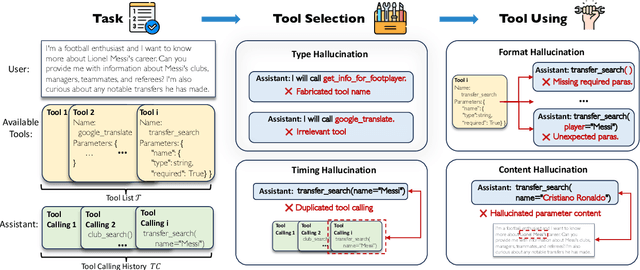
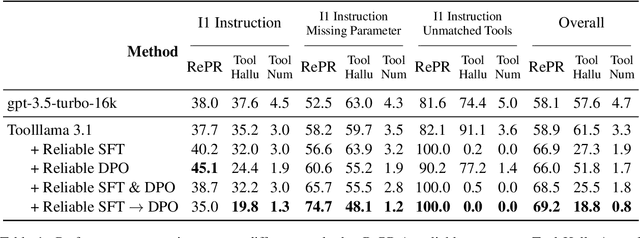
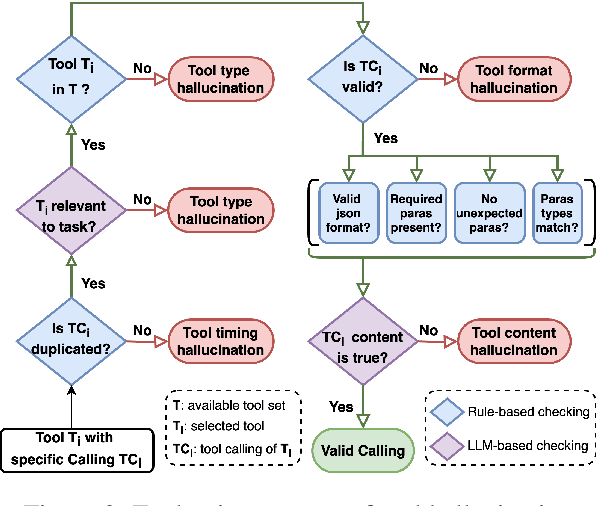
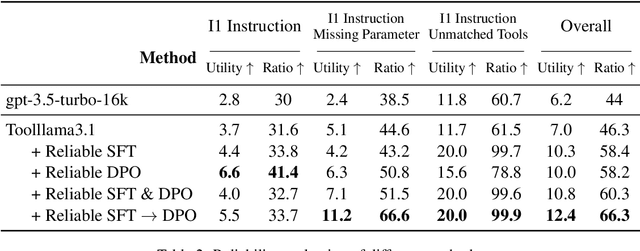
Abstract:Large Language Models (LLMs) have extended their capabilities beyond language generation to interact with external systems through tool calling, offering powerful potential for real-world applications. However, the phenomenon of tool hallucinations, which occur when models improperly select or misuse tools, presents critical challenges that can lead to flawed task execution and increased operational costs. This paper investigates the concept of reliable tool calling and highlights the necessity of addressing tool hallucinations. We systematically categorize tool hallucinations into two main types: tool selection hallucination and tool usage hallucination. To mitigate these issues, we propose a reliability-focused alignment framework that enhances the model's ability to accurately assess tool relevance and usage. By proposing a suite of evaluation metrics and evaluating on StableToolBench, we further demonstrate the effectiveness of our framework in mitigating tool hallucination and improving the overall system reliability of LLM tool calling.
Uni-Mol2: Exploring Molecular Pretraining Model at Scale
Jun 21, 2024Abstract:In recent years, pretraining models have made significant advancements in the fields of natural language processing (NLP), computer vision (CV), and life sciences. The significant advancements in NLP and CV are predominantly driven by the expansion of model parameters and data size, a phenomenon now recognized as the scaling laws. However, research exploring scaling law in molecular pretraining models remains unexplored. In this work, we present Uni-Mol2 , an innovative molecular pretraining model that leverages a two-track transformer to effectively integrate features at the atomic level, graph level, and geometry structure level. Along with this, we systematically investigate the scaling law within molecular pretraining models, characterizing the power-law correlations between validation loss and model size, dataset size, and computational resources. Consequently, we successfully scale Uni-Mol2 to 1.1 billion parameters through pretraining on 800 million conformations, making it the largest molecular pretraining model to date. Extensive experiments show consistent improvement in the downstream tasks as the model size grows. The Uni-Mol2 with 1.1B parameters also outperforms existing methods, achieving an average 27% improvement on the QM9 and 14% on COMPAS-1D dataset.
Uni-Mol Docking V2: Towards Realistic and Accurate Binding Pose Prediction
May 20, 2024



Abstract:In recent years, machine learning (ML) methods have emerged as promising alternatives for molecular docking, offering the potential for high accuracy without incurring prohibitive computational costs. However, recent studies have indicated that these ML models may overfit to quantitative metrics while neglecting the physical constraints inherent in the problem. In this work, we present Uni-Mol Docking V2, which demonstrates a remarkable improvement in performance, accurately predicting the binding poses of 77+% of ligands in the PoseBusters benchmark with an RMSD value of less than 2.0 {\AA}, and 75+% passing all quality checks. This represents a significant increase from the 62% achieved by the previous Uni-Mol Docking model. Notably, our Uni-Mol Docking approach generates chemically accurate predictions, circumventing issues such as chirality inversions and steric clashes that have plagued previous ML models. Furthermore, we observe enhanced performance in terms of high-quality predictions (RMSD values of less than 1.0 {\AA} and 1.5 {\AA}) and physical soundness when Uni-Mol Docking is combined with more physics-based methods like Uni-Dock. Our results represent a significant advancement in the application of artificial intelligence for scientific research, adopting a holistic approach to ligand docking that is well-suited for industrial applications in virtual screening and drug design. The code, data and service for Uni-Mol Docking are publicly available for use and further development in https://github.com/dptech-corp/Uni-Mol.
FusionFormer: A Multi-sensory Fusion in Bird's-Eye-View and Temporal Consistent Transformer for 3D Objection
Sep 11, 2023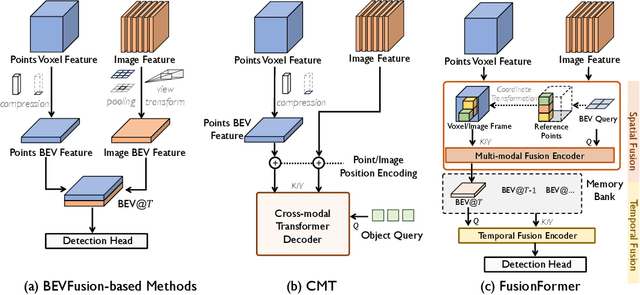
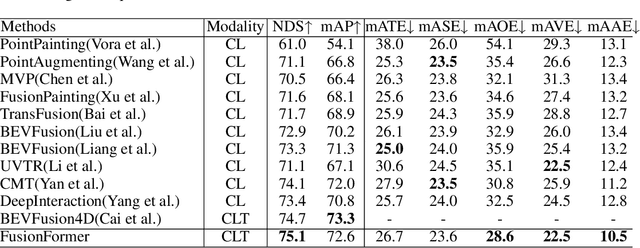


Abstract:Multi-sensor modal fusion has demonstrated strong advantages in 3D object detection tasks. However, existing methods that fuse multi-modal features through a simple channel concatenation require transformation features into bird's eye view space and may lose the information on Z-axis thus leads to inferior performance. To this end, we propose FusionFormer, an end-to-end multi-modal fusion framework that leverages transformers to fuse multi-modal features and obtain fused BEV features. And based on the flexible adaptability of FusionFormer to the input modality representation, we propose a depth prediction branch that can be added to the framework to improve detection performance in camera-based detection tasks. In addition, we propose a plug-and-play temporal fusion module based on transformers that can fuse historical frame BEV features for more stable and reliable detection results. We evaluate our method on the nuScenes dataset and achieve 72.6% mAP and 75.1% NDS for 3D object detection tasks, outperforming state-of-the-art methods.
FusionAD: Multi-modality Fusion for Prediction and Planning Tasks of Autonomous Driving
Aug 14, 2023



Abstract:Building a multi-modality multi-task neural network toward accurate and robust performance is a de-facto standard in perception task of autonomous driving. However, leveraging such data from multiple sensors to jointly optimize the prediction and planning tasks remains largely unexplored. In this paper, we present FusionAD, to the best of our knowledge, the first unified framework that fuse the information from two most critical sensors, camera and LiDAR, goes beyond perception task. Concretely, we first build a transformer based multi-modality fusion network to effectively produce fusion based features. In constrast to camera-based end-to-end method UniAD, we then establish a fusion aided modality-aware prediction and status-aware planning modules, dubbed FMSPnP that take advantages of multi-modality features. We conduct extensive experiments on commonly used benchmark nuScenes dataset, our FusionAD achieves state-of-the-art performance and surpassing baselines on average 15% on perception tasks like detection and tracking, 10% on occupancy prediction accuracy, reducing prediction error from 0.708 to 0.389 in ADE score and reduces the collision rate from 0.31% to only 0.12%.
CMDFusion: Bidirectional Fusion Network with Cross-modality Knowledge Distillation for LIDAR Semantic Segmentation
Jul 09, 2023Abstract:2D RGB images and 3D LIDAR point clouds provide complementary knowledge for the perception system of autonomous vehicles. Several 2D and 3D fusion methods have been explored for the LIDAR semantic segmentation task, but they suffer from different problems. 2D-to-3D fusion methods require strictly paired data during inference, which may not be available in real-world scenarios, while 3D-to-2D fusion methods cannot explicitly make full use of the 2D information. Therefore, we propose a Bidirectional Fusion Network with Cross-Modality Knowledge Distillation (CMDFusion) in this work. Our method has two contributions. First, our bidirectional fusion scheme explicitly and implicitly enhances the 3D feature via 2D-to-3D fusion and 3D-to-2D fusion, respectively, which surpasses either one of the single fusion schemes. Second, we distillate the 2D knowledge from a 2D network (Camera branch) to a 3D network (2D knowledge branch) so that the 3D network can generate 2D information even for those points not in the FOV (field of view) of the camera. In this way, RGB images are not required during inference anymore since the 2D knowledge branch provides 2D information according to the 3D LIDAR input. We show that our CMDFusion achieves the best performance among all fusion-based methods on SemanticKITTI and nuScenes datasets. The code will be released at https://github.com/Jun-CEN/CMDFusion.
Uni-QSAR: an Auto-ML Tool for Molecular Property Prediction
Apr 24, 2023



Abstract:Recently deep learning based quantitative structure-activity relationship (QSAR) models has shown surpassing performance than traditional methods for property prediction tasks in drug discovery. However, most DL based QSAR models are restricted to limited labeled data to achieve better performance, and also are sensitive to model scale and hyper-parameters. In this paper, we propose Uni-QSAR, a powerful Auto-ML tool for molecule property prediction tasks. Uni-QSAR combines molecular representation learning (MRL) of 1D sequential tokens, 2D topology graphs, and 3D conformers with pretraining models to leverage rich representation from large-scale unlabeled data. Without any manual fine-tuning or model selection, Uni-QSAR outperforms SOTA in 21/22 tasks of the Therapeutic Data Commons (TDC) benchmark under designed parallel workflow, with an average performance improvement of 6.09\%. Furthermore, we demonstrate the practical usefulness of Uni-QSAR in drug discovery domains.
Do Deep Learning Models Really Outperform Traditional Approaches in Molecular Docking?
Feb 23, 2023
Abstract:Molecular docking, given a ligand molecule and a ligand binding site (called ``pocket'') on a protein, predicting the binding mode of the protein-ligand complex, is a widely used technique in drug design. Many deep learning models have been developed for molecular docking, while most existing deep learning models perform docking on the whole protein, rather than on a given pocket as the traditional molecular docking approaches, which does not match common needs. What's more, they claim to perform better than traditional molecular docking, but the approach of comparison is not fair, since traditional methods are not designed for docking on the whole protein without a given pocket. In this paper, we design a series of experiments to examine the actual performance of these deep learning models and traditional methods. For a fair comparison, we decompose the docking on the whole protein into two steps, pocket searching and docking on a given pocket, and build pipelines to evaluate traditional methods and deep learning methods respectively. We find that deep learning models are actually good at pocket searching, but traditional methods are better than deep learning models at docking on given pockets. Overall, our work explicitly reveals some potential problems in current deep learning models for molecular docking and provides several suggestions for future works.
Do Deep Learning Methods Really Perform Better in Molecular Conformation Generation?
Feb 14, 2023Abstract:Molecular conformation generation (MCG) is a fundamental and important problem in drug discovery. Many traditional methods have been developed to solve the MCG problem, such as systematic searching, model-building, random searching, distance geometry, molecular dynamics, Monte Carlo methods, etc. However, they have some limitations depending on the molecular structures. Recently, there are plenty of deep learning based MCG methods, which claim they largely outperform the traditional methods. However, to our surprise, we design a simple and cheap algorithm (parameter-free) based on the traditional methods and find it is comparable to or even outperforms deep learning based MCG methods in the widely used GEOM-QM9 and GEOM-Drugs benchmarks. In particular, our design algorithm is simply the clustering of the RDKIT-generated conformations. We hope our findings can help the community to revise the deep learning methods for MCG. The code of the proposed algorithm could be found at https://gist.github.com/ZhouGengmo/5b565f51adafcd911c0bc115b2ef027c.
 Add to Chrome
Add to Chrome Add to Firefox
Add to Firefox Add to Edge
Add to Edge